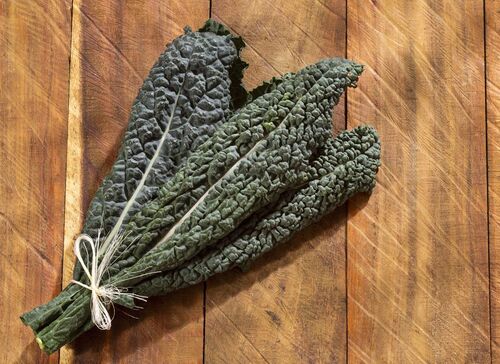Growing Black Palm Kale

Black Palm Kale have been cultivated in Italy since at least the 1700’s, and it still plays a big role in the southern Italian province Campania’s, culinary history. Today it is the most widely grown kale in Italy and an essential ingredient in the famed Tuscan Soup Rabolita.
It has long, strap-shaped foliage that is dark blue-green in color, and it is frequently called “dinosaur kale” because of the bumpy, savoyed texture of its leaves, reminiscent of reptile skin. When leaves are harvested from the bottom of these plants, they take on a palm tree-like appearance as they grow, which account for another of its common names, “palm kale.”
Other names are Cavolo Nero, Nero di Toscana, Tuscan Kale, Lacinato Kale, Dinosaur Kale, Italian Kale.
Sowing black palm kale
Black palm kale is easy to grow, and like other kale varieties, it is considered a nutritional powerhouse. Plant and raise palm kale the same way that you would grow other common kale varieties.
Direct to the palmkale seeds >
This vegetable is a cool season crop, so it’s best to sow seeds in spring or fall. As a general rule, you can direct sow this leafy green one or two weeks before your last spring frost, or ten to twelve weeks before your first fall frost. Or, if you prefer, you can also start seedlings indoors about six weeks before you want to transplant them. Make sure you set out your transplants before the weather heats up in the spring, and be sure to harden them off gradually before planting out.
Growing black palm kale
Black palm kale should be grown in full or part sun, and in well-drained soil amended with organic matter such as compost. Black palm kale can also be grown in raised beds, where it will be particularly happy when situated among some of its favorite companion plants. Black palm kale needs about one inch of water a week, but you’ll need to increase watering during periods of hot weather.
Plants grow to two or three feet tall and have leaves that can reach two feet long. This cultivar provides full-sized leaves ready for harvest in 65-80 days.
7 Companion plants to grow with black palm kale :
- Cilantro: Cilantro is one of the best companion plants for kale because it attracts beneficial insects like hoverflies that prey on common pests like aphids.
- Dill: Dill is more than just a great ingredient for pickling, it makes a good companion plant for kale and other vegetables. In addition to attracting pollinators that aid plant growth, dill attracts beneficial insects that prey on pests. Planting dill near kale will protect kale seedlings as they mature.
- Alliums: Alliums like chives, shallots, and leeks deter common pests like flea beetles, cabbage loopers, and aphids that prey on kale leaves.
- Legumes: Legumes of all varieties enrich the soil around your kale by increasing the soil’s nitrogen content. Planting pole beans or bush beans in your garden can help you grow healthy, flavorful kale.
- Catnip: Catnip is a useful companion plant that can aid a variety of vegetables and flowers by repelling pests and attracting beneficial insect predators. Plant catnip around your garden to protect your kale from pests.
- Marigolds: Flowers like marigolds and sweet alyssum attract hoverflies that feed on aphids and prevent them from damaging your kale plants.
- Buckwheat: Buckwheat serves as a ground cover, sealing moisture in the soil and smothering weeds so your kale can grow in ideal conditions. Buckwheat also attracts beneficial insects and increases the nitrogen content of the soil.
Black palm kale Pests
The best way to protect black palm kale from pests organically is by keeping weeds down around the plants, inspecting the plants regularly, and removing pests by hand. Small populations of aphids can be removed with a strong jet of water from your hose.
Pest populations are also kept under control with the help of predatory insects like praying mantises, spiders, and wasps. You can give them a welcoming home by avoiding the use of pesticides, and planting cosmos, dill, and cilantro nearby to provide habitat and forage for these beneficial insects.
Harvesting black palm kale
You can harvest black palm kale when it’s leaves are small for baby greens, approximately 25-30 days after sowing.
Or allow the foliage to mature and grow to full size and start harvesting about 60-80 days after you put your seeds in the soil.
Harvest the largest bottom leaves first, rather than the topmost inner leaves. This will encourage your crop to keep producing more leafy greens, and will give your plants that palm tree appearance this brassica is known for.
Varieties of Palm Cabbage seeds
In our webshop we have 3 types of palm cabbage from different brands:
- Organic Palm cabbage seeds from Buzzy Seeds
- Palm cabbage seeds for the Easy Vegetable Garden
- Palm cabbage seeds from Buzzy Seeds
The taste of black palm kale
Because of it’s excellent flavour and texture, black palm kale is the most sought after kale by cooks. With its sweet flavour and little bitterness, it is a favourite for soups and stews, and is also one of the traditional ingredients of minestrone. Young leaves can be eaten raw in salads. Kale chips (leaves, rubbed with olive oil and baked until crispy) has also started to gain in popularity.
Kale also is very nutritious for you, with high amounts of phosphorus, vitamins A, C, and K, lots of fibre and antioxidants.
Freezing black palm kale
Black palm kale can be frozen, but it keeps its flavor best if blanched or otherwise cooked first.
That’s because enzymes present on raw produce remain active after freezing, and will alter the flavor or texture of raw frozen produce.
Dehydrating
If you tend to run out of room for storing your garden’s bounty in your freezer, a good backup plan is dehydration.
Like many other garden veggies, black palm kale can be dried in an oven set at a low temperature, or in a food dehydrator. Refer to the instructions on your dehydrator for heat and time recommendations.



